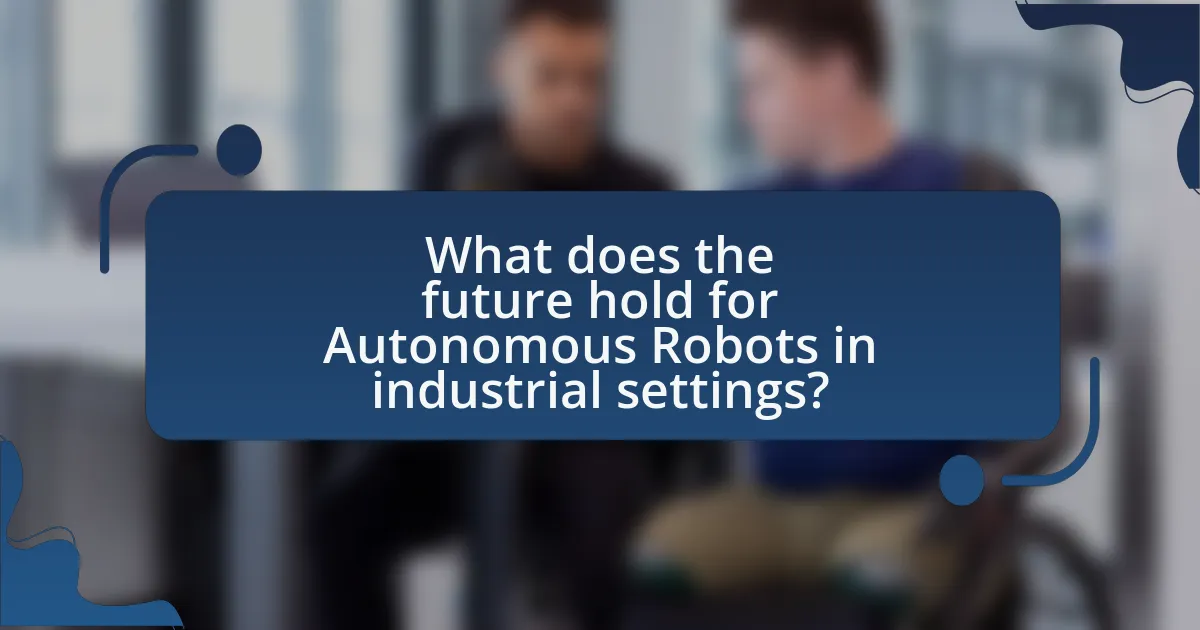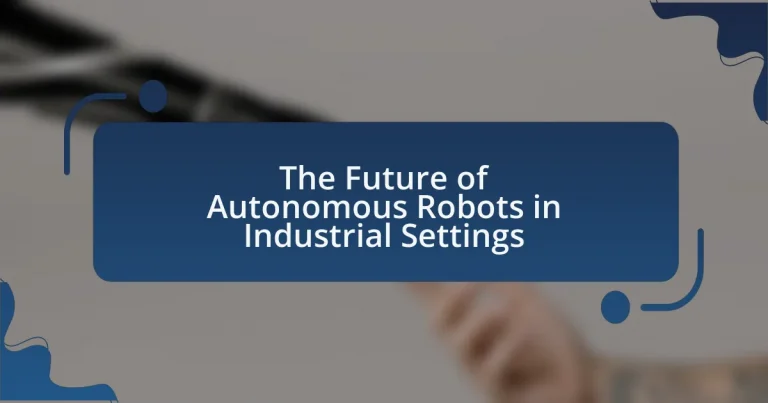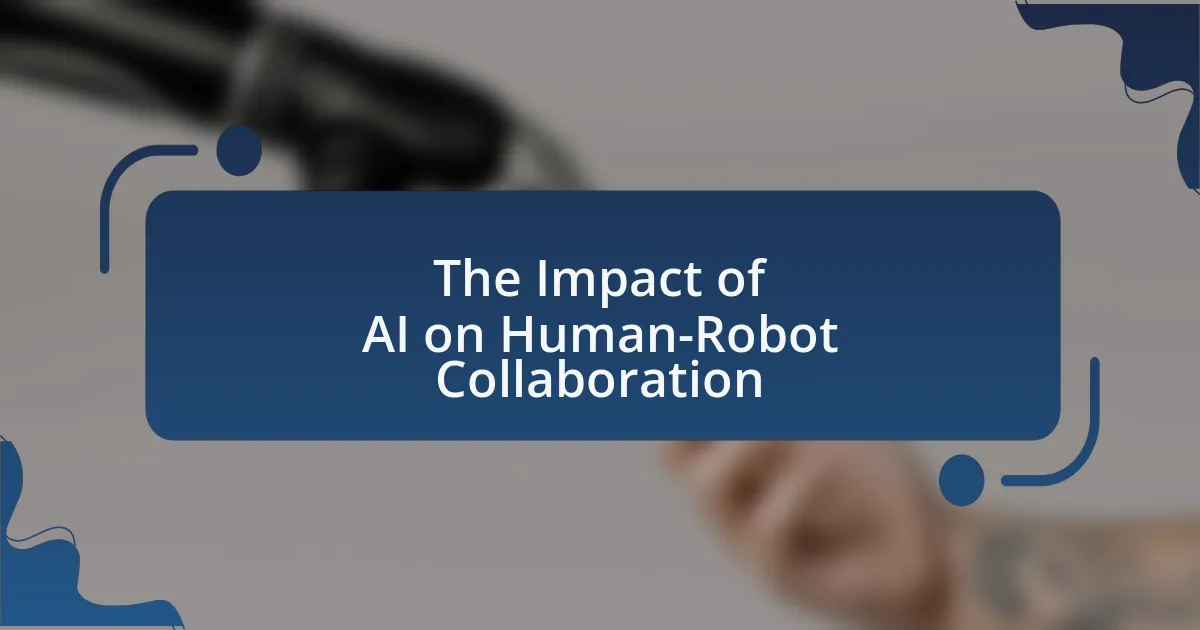Autonomous robots in industrial settings are advanced machines that perform tasks without human intervention, utilizing technologies such as artificial intelligence, sensors, and machine learning. This article explores their operational mechanisms, key technologies, and the benefits they bring, including increased efficiency, enhanced safety, and cost reduction. It also addresses the challenges industries face in integrating these robots, such as high initial costs and workforce adaptation. Furthermore, the article examines the current state of autonomous robots across various sectors, their future evolution, and the potential impacts on the workforce, highlighting the importance of training and best practices for successful implementation.

What are Autonomous Robots in Industrial Settings?
Autonomous robots in industrial settings are machines capable of performing tasks without human intervention, utilizing advanced technologies such as artificial intelligence, sensors, and machine learning. These robots can navigate their environment, make decisions, and execute complex operations, enhancing efficiency and productivity in manufacturing, logistics, and warehousing. For instance, a study by the International Federation of Robotics reported that the global stock of industrial robots reached 2.7 million units in 2020, demonstrating their growing prevalence and impact on industrial processes.
How do Autonomous Robots operate in industrial environments?
Autonomous robots operate in industrial environments by utilizing advanced sensors, artificial intelligence, and machine learning algorithms to navigate and perform tasks without human intervention. These robots are equipped with technologies such as LiDAR, cameras, and ultrasonic sensors that allow them to perceive their surroundings, identify obstacles, and make real-time decisions. For instance, in a warehouse setting, autonomous mobile robots can transport goods efficiently by mapping the layout and optimizing their routes based on dynamic conditions. The effectiveness of these robots is supported by data indicating that companies implementing autonomous systems can achieve up to a 30% increase in operational efficiency and a significant reduction in labor costs.
What technologies enable the functionality of Autonomous Robots?
Autonomous robots function through a combination of technologies including artificial intelligence (AI), machine learning, sensors, and computer vision. AI enables robots to process data and make decisions, while machine learning allows them to improve their performance over time through experience. Sensors, such as LiDAR and ultrasonic sensors, provide real-time environmental data, and computer vision systems help robots interpret visual information, facilitating navigation and object recognition. These technologies collectively enhance the robots’ ability to operate independently in complex industrial environments, as evidenced by their increasing deployment in manufacturing and logistics sectors, where they perform tasks such as assembly, inspection, and material handling with high efficiency and accuracy.
How do sensors and AI contribute to the operation of Autonomous Robots?
Sensors and AI are crucial for the operation of autonomous robots as they enable perception, decision-making, and action execution. Sensors, such as cameras, LIDAR, and ultrasonic devices, provide real-time data about the robot’s environment, allowing it to detect obstacles, identify objects, and navigate effectively. AI algorithms process this sensory data to interpret the surroundings, make informed decisions, and adapt to dynamic conditions. For instance, a study by the Massachusetts Institute of Technology demonstrated that integrating AI with sensor data significantly improved the navigation accuracy of autonomous robots in complex environments, achieving a 95% success rate in obstacle avoidance. This synergy between sensors and AI enhances the robots’ operational efficiency and safety in industrial settings.
What are the key benefits of using Autonomous Robots in industries?
The key benefits of using Autonomous Robots in industries include increased efficiency, enhanced safety, and cost reduction. Autonomous robots can operate continuously without fatigue, leading to higher productivity levels; for instance, a study by McKinsey & Company found that automation can increase productivity by up to 30% in manufacturing settings. Additionally, these robots can perform hazardous tasks, reducing the risk of workplace injuries; according to the Occupational Safety and Health Administration (OSHA), automation can decrease workplace accidents by up to 50%. Finally, the implementation of autonomous robots can lower operational costs by minimizing labor expenses and reducing errors, with a report from PwC indicating that automation could contribute to a potential $15 trillion boost to the global economy by 2030.
How do Autonomous Robots improve efficiency and productivity?
Autonomous robots improve efficiency and productivity by automating repetitive tasks, which reduces human error and increases operational speed. For instance, in manufacturing, robots can perform assembly line tasks continuously without fatigue, leading to higher output rates. A study by McKinsey & Company found that automation can increase productivity by up to 30% in certain industries by streamlining processes and minimizing downtime. Additionally, autonomous robots can operate in hazardous environments, allowing human workers to focus on more complex tasks, further enhancing overall productivity.
What cost savings can be achieved through the implementation of Autonomous Robots?
The implementation of Autonomous Robots can achieve significant cost savings primarily through labor reduction, increased efficiency, and minimized operational errors. Autonomous Robots can operate continuously without breaks, leading to higher productivity levels compared to human workers. For instance, a study by McKinsey & Company indicates that automation can increase productivity by up to 30% in certain industrial sectors. Additionally, these robots reduce labor costs by performing tasks that would otherwise require multiple employees, thus lowering payroll expenses. Furthermore, the precision of Autonomous Robots decreases the likelihood of costly errors, which can save companies substantial amounts in rework and waste. Overall, the integration of Autonomous Robots in industrial settings can lead to a comprehensive reduction in operational costs, enhancing profitability.
What challenges do industries face when integrating Autonomous Robots?
Industries face several challenges when integrating autonomous robots, including high initial costs, technical complexity, and workforce adaptation. High initial costs can deter investment, as companies must allocate significant resources for purchasing, implementing, and maintaining robotic systems. Technical complexity arises from the need for advanced programming, integration with existing systems, and ensuring reliability in diverse operational environments. Workforce adaptation is crucial, as employees may require retraining to work alongside robots, leading to resistance or fear of job displacement. According to a report by McKinsey, 60% of jobs could be automated, highlighting the need for effective workforce transition strategies to mitigate these challenges.
What are the common technical hurdles in deploying Autonomous Robots?
Common technical hurdles in deploying autonomous robots include sensor limitations, navigation challenges, and integration with existing systems. Sensor limitations arise from the inability of current technologies to accurately perceive complex environments, which can lead to navigation errors. Navigation challenges involve the need for real-time processing and decision-making in dynamic settings, where obstacles and changes in the environment can occur unexpectedly. Integration with existing systems is complicated by compatibility issues and the need for seamless communication between robots and other machinery or software, which can hinder operational efficiency. These hurdles are supported by studies indicating that sensor accuracy and system interoperability are critical factors for successful deployment in industrial settings.
How do workforce concerns impact the adoption of Autonomous Robots?
Workforce concerns significantly hinder the adoption of Autonomous Robots due to fears of job displacement and the need for reskilling. Employees often perceive these robots as threats to their job security, leading to resistance against their implementation. For instance, a survey by McKinsey & Company found that 60% of workers expressed anxiety about automation replacing their roles. This apprehension can result in decreased morale and productivity, ultimately slowing down the integration of autonomous technologies in industrial settings. Additionally, companies face challenges in addressing the skills gap, as existing employees may require training to work alongside robots effectively, further complicating the adoption process.

What is the current state of Autonomous Robots in industrial settings?
The current state of autonomous robots in industrial settings is characterized by widespread adoption and integration into various manufacturing processes. Many industries, including automotive, electronics, and logistics, utilize autonomous robots for tasks such as assembly, material handling, and quality inspection. According to a report by the International Federation of Robotics, the global stock of operational industrial robots reached approximately 3 million units in 2021, reflecting a growth rate of 10% compared to the previous year. This trend indicates a significant shift towards automation, driven by advancements in artificial intelligence, machine learning, and sensor technologies, which enhance the robots’ capabilities to operate safely and efficiently alongside human workers.
How widespread is the adoption of Autonomous Robots across different industries?
The adoption of Autonomous Robots is increasingly widespread across various industries, with significant implementations in sectors such as manufacturing, logistics, healthcare, and agriculture. For instance, a report by the International Federation of Robotics indicates that global sales of industrial robots reached approximately 384,000 units in 2020, showcasing a 12% increase from the previous year, reflecting a growing trend in manufacturing automation. Additionally, in logistics, companies like Amazon have integrated autonomous robots in their warehouses, enhancing efficiency and reducing operational costs. In healthcare, robots are being utilized for tasks ranging from surgery assistance to patient care, demonstrating their versatility and effectiveness. This trend indicates a robust and expanding presence of autonomous robots across multiple sectors.
Which sectors are leading in the use of Autonomous Robots?
The sectors leading in the use of Autonomous Robots include manufacturing, logistics, healthcare, and agriculture. In manufacturing, robots are utilized for assembly, welding, and quality control, enhancing efficiency and precision. The logistics sector employs autonomous robots for warehousing and delivery, significantly reducing operational costs and improving speed. In healthcare, robots assist in surgeries and patient care, increasing safety and accuracy. Agriculture utilizes autonomous robots for planting, harvesting, and monitoring crops, which boosts productivity and reduces labor costs. These sectors demonstrate a strong adoption of autonomous robots, driven by advancements in technology and the need for increased efficiency.
What are the most common applications of Autonomous Robots today?
The most common applications of autonomous robots today include manufacturing, logistics, healthcare, and agriculture. In manufacturing, robots are utilized for assembly, welding, and painting, enhancing efficiency and precision. In logistics, autonomous robots manage inventory, transport goods, and optimize warehouse operations, significantly reducing operational costs. In healthcare, robots assist in surgeries, patient care, and medication delivery, improving patient outcomes and operational efficiency. In agriculture, autonomous robots are employed for planting, harvesting, and monitoring crops, leading to increased productivity and reduced labor costs. These applications are supported by advancements in artificial intelligence and machine learning, which enable robots to perform complex tasks with minimal human intervention.
What advancements are being made in Autonomous Robot technology?
Advancements in Autonomous Robot technology include enhanced machine learning algorithms, improved sensor integration, and increased collaboration capabilities. These developments enable robots to navigate complex environments more effectively, adapt to dynamic tasks, and work alongside human operators. For instance, recent research from MIT demonstrates that robots equipped with advanced perception systems can identify and manipulate objects in cluttered spaces with over 90% accuracy. Additionally, companies like Boston Dynamics are pioneering robots that can perform intricate tasks in real-time, showcasing the potential for autonomous systems to revolutionize industrial workflows.
How is machine learning enhancing the capabilities of Autonomous Robots?
Machine learning enhances the capabilities of autonomous robots by enabling them to learn from data, adapt to new environments, and improve their decision-making processes. This technology allows robots to analyze vast amounts of sensory data, recognize patterns, and make predictions, which significantly increases their operational efficiency. For instance, in industrial settings, machine learning algorithms can optimize robotic movements for tasks such as assembly or quality control, leading to reduced errors and increased productivity. Research has shown that companies implementing machine learning in their robotic systems have experienced up to a 30% increase in efficiency, demonstrating the tangible benefits of this technology in enhancing autonomous robot capabilities.
What role does collaborative robotics play in the future of Autonomous Robots?
Collaborative robotics will significantly enhance the future of autonomous robots by enabling seamless interaction between humans and machines in industrial settings. This integration allows for improved efficiency, safety, and productivity, as collaborative robots, or cobots, are designed to work alongside human operators, sharing tasks and responsibilities. For instance, a study by the International Federation of Robotics indicates that the adoption of collaborative robots can increase productivity by up to 30% in manufacturing environments. This collaborative approach not only optimizes workflows but also reduces the risk of accidents, as cobots are equipped with advanced sensors and safety features that allow them to operate safely in close proximity to humans. Thus, the role of collaborative robotics is pivotal in shaping a future where autonomous robots can effectively complement human labor in various industrial applications.

What does the future hold for Autonomous Robots in industrial settings?
The future of autonomous robots in industrial settings is characterized by increased integration, enhanced capabilities, and greater efficiency. As industries adopt advanced technologies such as artificial intelligence and machine learning, autonomous robots will become more adept at performing complex tasks, leading to improved productivity and reduced operational costs. According to a report by McKinsey, automation could increase global productivity by 0.8 to 1.4 percent annually, highlighting the significant impact autonomous robots will have on industrial operations. Furthermore, the International Federation of Robotics projects that the global stock of industrial robots will reach 4 million units by 2025, indicating a strong trend towards automation in manufacturing and logistics.
How will Autonomous Robots evolve in the next decade?
Autonomous robots will evolve significantly in the next decade through advancements in artificial intelligence, machine learning, and sensor technology. These improvements will enable robots to perform complex tasks with greater autonomy and efficiency, enhancing their capabilities in industrial settings. For instance, the integration of AI algorithms will allow robots to learn from their environments and adapt to new challenges, leading to increased productivity and reduced operational costs. According to a report by McKinsey & Company, automation could raise global productivity by 0.8 to 1.4 percent annually, indicating a substantial impact on industries that adopt these technologies. Additionally, advancements in sensor technology will improve robots’ perception and decision-making abilities, allowing them to navigate dynamic environments safely and effectively.
What emerging technologies are likely to influence the development of Autonomous Robots?
Emerging technologies likely to influence the development of autonomous robots include artificial intelligence (AI), machine learning, computer vision, and advanced sensors. AI and machine learning enable robots to learn from data and improve their decision-making capabilities, enhancing their autonomy. Computer vision allows robots to interpret and understand their surroundings, facilitating navigation and interaction with objects. Advanced sensors, such as LiDAR and ultrasonic sensors, provide critical environmental data, improving the robots’ ability to operate safely and efficiently in complex industrial settings. These technologies collectively drive the evolution of autonomous robots, making them more capable and adaptable for various applications.
How might regulations shape the future of Autonomous Robots in industries?
Regulations will significantly shape the future of autonomous robots in industries by establishing safety standards and operational guidelines. These regulations will ensure that robots operate safely alongside human workers, minimizing risks of accidents and injuries. For instance, the ISO 13482 standard, which focuses on safety requirements for personal care robots, exemplifies how regulatory frameworks can guide the design and implementation of autonomous systems. Furthermore, compliance with data protection regulations, such as GDPR, will influence how robots collect and process personal data, thereby affecting their deployment in sectors like healthcare and retail. Overall, regulations will drive innovation by setting clear parameters for safety, data privacy, and ethical considerations, ultimately fostering public trust and acceptance of autonomous robots in various industrial applications.
What are the potential impacts of Autonomous Robots on the workforce?
Autonomous robots are likely to significantly transform the workforce by increasing efficiency and reducing the need for manual labor in various industries. These robots can perform repetitive tasks with precision and speed, leading to higher productivity levels. For instance, a study by McKinsey Global Institute estimates that automation could displace up to 800 million jobs globally by 2030, while simultaneously creating new roles that require advanced skills in technology and robotics. This shift may lead to a demand for workers who can manage, maintain, and program these autonomous systems, thereby changing the skill requirements in the labor market.
How can industries prepare their workforce for the integration of Autonomous Robots?
Industries can prepare their workforce for the integration of Autonomous Robots by implementing comprehensive training programs focused on robotics, automation technologies, and collaborative work practices. These training programs should include hands-on experience with robotic systems, understanding programming and maintenance, and fostering skills in human-robot collaboration. According to a report by the World Economic Forum, up to 85 million jobs may be displaced by automation by 2025, highlighting the necessity for reskilling and upskilling initiatives to ensure workers can adapt to new technologies. Additionally, industries should promote a culture of continuous learning and adaptability, which is essential for successfully integrating autonomous robots into existing workflows.
What new job opportunities might arise from the use of Autonomous Robots?
The use of Autonomous Robots is likely to create new job opportunities in areas such as robot maintenance, programming, and oversight. As industries increasingly adopt these technologies, there will be a demand for skilled technicians to maintain and repair robots, ensuring they operate efficiently. Additionally, programming roles will emerge to develop and optimize algorithms that enhance robot functionality. Furthermore, positions focused on monitoring and managing robotic systems will be necessary to ensure safety and productivity in industrial settings. According to a report by the World Economic Forum, automation could create 133 million new roles globally by 2022, highlighting the potential for job growth in sectors influenced by autonomous technologies.
What best practices should industries follow when implementing Autonomous Robots?
Industries should prioritize safety, integration, and continuous training when implementing autonomous robots. Ensuring safety involves conducting thorough risk assessments and adhering to safety standards, such as ISO 10218 for industrial robots, which outlines safety requirements. Integration requires seamless collaboration between robots and existing systems, utilizing standardized communication protocols like ROS (Robot Operating System) to enhance interoperability. Continuous training for employees is essential to maximize the benefits of autonomous robots; studies show that organizations investing in workforce training see a 20% increase in productivity. By focusing on these best practices, industries can effectively harness the potential of autonomous robots while minimizing risks and enhancing operational efficiency.
How can companies ensure a smooth transition to using Autonomous Robots?
Companies can ensure a smooth transition to using Autonomous Robots by implementing a structured change management strategy. This involves assessing current workflows, identifying areas for automation, and providing comprehensive training for employees to work alongside robots. Research indicates that organizations that prioritize employee engagement and training during technological transitions experience a 70% higher success rate in adoption (McKinsey & Company, 2021). Additionally, establishing clear communication channels and involving employees in the transition process fosters acceptance and reduces resistance. By addressing these factors, companies can effectively integrate Autonomous Robots into their operations, enhancing productivity and efficiency.
What strategies can be employed to maximize the benefits of Autonomous Robots?
To maximize the benefits of Autonomous Robots, organizations should implement strategies such as integrating advanced AI algorithms, ensuring seamless human-robot collaboration, and investing in continuous training and maintenance. Advanced AI algorithms enhance decision-making capabilities, allowing robots to adapt to dynamic environments, which is crucial in industrial settings where efficiency is paramount. Seamless human-robot collaboration fosters a productive work environment, as studies show that teams combining human intelligence with robotic precision can increase productivity by up to 30%. Continuous training and maintenance ensure that robots operate at peak performance, reducing downtime and operational costs, which can lead to a 20% increase in overall efficiency.





